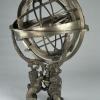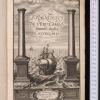2. Magnetic Compass
Commentary
Inscription translated: ‘COMPASS [literally ‘POLAR STONE’], MAGNET. This stone revealed his hidden love for the north pole to Flavius, and he himself [revealed it] to the sailor.’
Description. In the foreground, bottom left, sits a primitive compass consisting of a loadstone floating on a piece of wood within a large, elaborately sculpted basin of liquid. At the desk sits ‘Flavius Amalfitanus’, the supposed inventor of the magnetic compass, a dog at his feet, studying a book while measuring with a pair of dividers another, more sophisticated compass, possibly in the making, complete with a wind rose. On his desk and the nearby table, numerous instruments associated with navigation and magnetism: a terrestrial globe, an hourglass, a versorium, and an armillary sphere. Outside the window, the port of Amalfi with a small ship propelled by oars and lateen rigging. In front of him, incongruously floating in the middle of the room, is a modern sixteenth-century, ocean-going ship in full sail, square rigged with three masts, equipped with cannon and portholes.
The compass and Amalfi. The inventor of the compass is unknown, and its subsequent refinement and dissemination are poorly understood; but its spread throughout the Mediterranean has been ascribed to sailors from the city of Amalfi. Amalfi was one of the four maritime republics (along with Venice, Genoa, and Pisa) responsible for most of the commerce between western Europe and the Levant, so they were likely to have encountered the compass from Arab sailors in Syria and Egypt during the Crusades sometime in the 12th century.
'Flavius Amalfitanus'. A simple philological error subsequently ascribed it to Flavio Gioia of Amalfi. In the mid-fif teenth, the historian Flavio Biondo wrote that the compass was invented and perfected by the Amalfitans. The Bolognese philologist Giambattista Pio in 1511 reported the news in this way: ‘Amalphi in Campania veteri magnetis usus inventus, a Flavio traditur’ (that is, ‘In Amalfi, Campania, the use of the magnet was invented, according to Flavio’). By placing a comma after ‘inventus’, the writer meant merely that Flavio Biondo had ascribed this invention to Amalfi. But subsequent narrators moved the comma in a manner which ascribed the invention itself to Flavius Amalfitanus: ‘… magnetis usus inventus a Flavio, traditur" (‘… the use of the magnet was invented by Flavio, it is said’). A more willful extravagance by the sixteenth-century Neapolitan historian, Scipione Mazzella, identified this Flavio with the one born in Gioia in Puglia. Thanks to a misplaced comma, a handsome monument to Flavio Gioia, ‘the inventor of the compass’, stood in Amalfi until a few years ago. So this engraving illustrates the story of how Europeans claimed credit for technological innovations now generally regarded as originating in Asia.
Interpretation. Flavio is presented as a scholar, reading one book and surrounded by others; as an author, with pen, inkpot, and a manuscript page on the table before him; and as a philosopher or mathematician, surrounded by astronomical and mathematical instruments. His is not a sailor, navigators or merchant but as someone who ‘reveals’ the secret of the compass to the sailor. Described as a revelator, he is also depicted as a visionary: the ship, miraculously hovering before him, is a complete anachronism. The ships of his own day, seen through the window in the bay of Amalfi, are depicted as small, single-masted, lateen-rigged vessels also propelled by oars. The vessel floating in Flavio’s study, however, is mature carrack from the first half of the sixteenth century: a large, three-masted ship, lateen-rigged on the mizzenmast, but square-rigged on the foremast and mainmast. The topsail was added to the mainmast in the late 15th century and to the foremast somewhat later. The muzzle-loaded guns on wheeled trucks, poking through the hinged gun ports, were a mid-sixteenth-century innovation. The rounded stern and towering castles fore and aft most clearly distinguish the carrack from the galleons which superseded them as the dominant design by the end of the sixteenth century. So this is a vessel contemporaneous with Stradanus rather than Flavio.
The Carrack evolved from the Caravel for commerce on the Atlantic: first between the Mediterranean and the Baltic, then down the coast of Africa, and eventually for trade with Asia and America. Solidly constructed and broad of beam, large enough for stability in heavy seas, they could also hold the cargo and provisions required for commercial voyages of unprecedented length. These, in short, were the vessels which carried Europeans on their voyages of discovery. Columbus’s flagship in 1492, the Santa Maria, was a carrack. So was Vasco da Gama’s flagship, the São Gabriel, on his first voyage to India in 1497-9, and the entire fleet with which Magellan set out on his circumnavigation in 1519.
As Flavio works out the details of the nautical compass, therefore, a vision of the future of trans-oceanic, global trade and expanding European empire materializes in front of him, which his invention will make possible.
Credits. Howard Hotson (May 2021)


